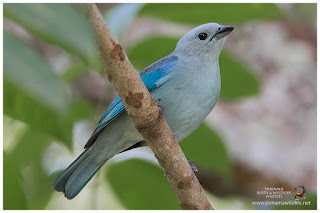In February we made a short visit to Parque Natural Metropolitano to try to get pictures of the Common Potoo (Nyctibius griseus) which is usually observed in the area. While we walked the open areas and the trails we took the opportunity to make some pictures of other species.
Blue-gray Tanager (Thraupis episcopus)
House Wren (Troglodytes aedon)
Variable Seedeater (Sporophila corvina)
One of the surprises was finding a
Paltry Tyrannulet (Zimmerius vilissimus) at low level at an
annatto or achiote bush (Bixa orellana) because they are usually seen high in trees.
The Paltry Tyrannulet (Zimmerius vilissimus) is a very small bird in the tyrant flycatcher family. It breeds from southern Mexico to Panama. Is a common bird from the lowlands to 3000 m (9,850 ft) altitude, mainly in humid regions. It can be found in forests, second growth, pasture and plantations with trees, and shady gardens.
Measuring 9.5 cm (3.7 in) long, the upperparts are olive-green other than a dull grey crown to the head and grey supercilia. The wings are blackish with yellow feather edging but no wing bars, and the longish tail is dusky. It is an active bird, eats mainly mistletoe, but also other berries and small insects. In Panama it's common and inhabits forest canopy.
Olivaceous Woodcreeper (Sittasomus griseicapillus)
Slaty-tailed Trogon (Trogon massena) - male
White-shouldered Tanager (Tachyphonus luctuosus) - male
Yellow-backed Oriole (Icterus chrysater) is found throughout Central America and northern South America. In particular Belize, Colombia, El Salvador, Guatemala, Honduras, Mexico, Nicaragua, Panama, and Venezuela. Yellow-backed orioles are insectivorous. Their diet consists primarily of caterpillars, wasps, ants, weevils, and other arthropods. This species' diet is often augmented with bananas and may also include nectar from balsa and heliconia. It's distinguished from Yellow-tailed Oriole by lack of yellow on tail and on wing coverts. In Panama it's fairly common form Veraguas eastward to Darién, and found in upper levels of forest and woodland, and in shrubby areas with trees.


The
Common Potoo (Nyctibius griseus), is a nocturnal bird which breeds in tropical Central and South America from Nicaragua to northern Argentina and northern Uruguay. It is 33–38 cm (13-15 in) long and pale greyish to
brown,
finely patterned with black and buff,
camouflaged to look like a log; this is a safety measure to help protect it from predators, but its mode of perch is also a camouflage. It has large orange eyes.
The common potoo can be located at night by the reflection of light from its eyes as it sits on a post, or by its haunting melancholic song. It camouflages into a branch, as shown on the pictures.
It is a resident of open woodlands and savannah. It avoids cooler montane regions, rarely occurring over 1,900 meters (6,200 ft). It is insectivore , and hunts from a perch like a flycatcher. During the day it perches upright on a tree stump, and is completely invisible, looking like part of the stump because it stays so completely still as it perches. In Panama it's
fairly common, and found in
upper levels of forest edge, woodland, second growth, and clearings.
















Comments
Post a Comment